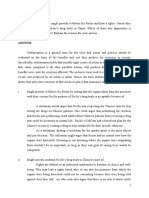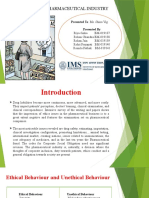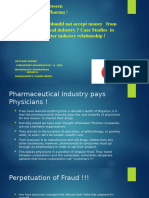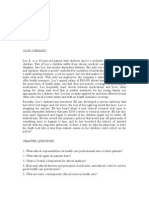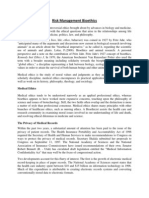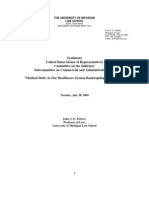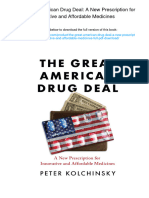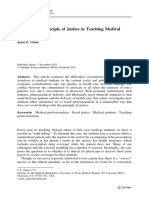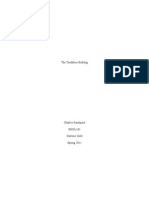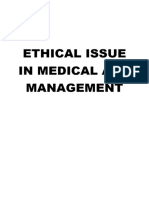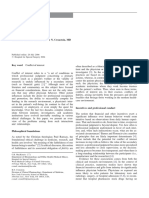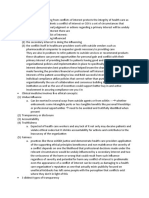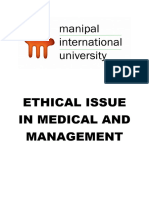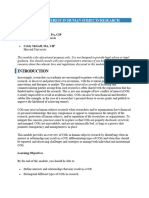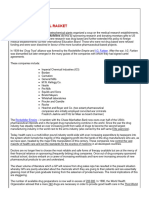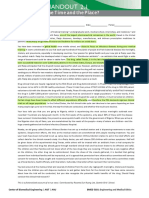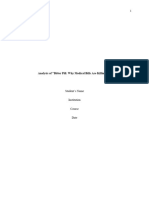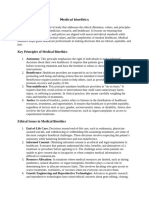Six Problems
Six Problems
Uploaded by
Victoria FederiucCopyright:
Available Formats
Six Problems
Six Problems
Uploaded by
Victoria FederiucCopyright
Available Formats
Share this document
Did you find this document useful?
Is this content inappropriate?
Copyright:
Available Formats
Six Problems
Six Problems
Uploaded by
Victoria FederiucCopyright:
Available Formats
Stud. Hist. Phil. Biol. & Biomed. Sci. 35 (2004) 125129 www.elsevier.
com/locate/shpsc
Six problems with pharma-funded bioethics
Carl Elliott
Center for Bioethics, University of Minnesota, N504 Boynton, 410 Church Street SE, Minneapolis, MN 55455-0346, USA
For a long time weve known about drug industry gifts to doctors. Weve known about the expense-paid trips to exotic locations, the entertainment extravaganzas at medical conferences, the consulting fees that doctors can collect merely for listening to a marketer.1 Weve known about the seeding trials to market new drugs, the nders fees the industry pays to researchers for enrolling patients in research studies, and the scientic publications ghost-written by industry-employed PR rms.2 Were also beginning to learn about the class action lawsuits, the fraud charges, the suppressed research data and the recalled prescription drugs.3 What we did not know, until recently, was that the drug industry is also giving lots of money to bioethics. Should we be worried? Many bioethicists think not. Last year, a task force commissioned by the two major bioethics associations in the United States published a report that strongly endorsed for-prot bioethics consultation.4 Some bioethicists suggest that the eld will ounder if it is disengaged from the private sector. A bioethics that is disconnected from industry is a bioethics that ies blind, Arthur Caplan of the University of Pennsylvania told the New York Times.5 Even bioethicists who are skeptical about corporate-funded bioethics believe that the solution is for bioethicists merely to disclose their corporate links.
1 2 3 4 5
E-mail address: ellio023@umn.edu (C. Elliott). Fuller Torrey (2002); Moynihan (2003); Kowalczyk (2002). La Puma & Kraut (1994); Eichenwald & Kolata (1999); Bosely (2002). Petersen (2002a,b); Petersen (2003); Laurance (2003a,b); Horton (2000). Brody, et al. (2002). Stolberg (2001).
1369-8486/$ - see front matter # 2003 Elsevier Ltd. All rights reserved. doi:10.1016/j.shpsc.2003.12.008
126
C. Elliott / Stud. Hist. Phil. Biol. & Biomed. Sci. 35 (2004) 125129
The view from outside the eld has been very dierent. Many observers have been shocked at the notion that bioethicists would be on the pharmaceutical industry payroll.6 Journalists have professed dismay at discovering that many of the bioethicists from whom they have been seeking commentary and guidance have been secretly cashing checks from Janssen and Glaxo SmithKline.7 But maybe they should not have been surprised. With no consensus within the eld of bioethics on either the institutional role of bioethicists or what they should be doing, it is no surprise to nd disagreement about what sorts of funding are appropriate. I believe there are a number of good reasons why bioethicists should be very wary of corporate funding. The rst problem is simply that of drug costs. Whatever money bioethicists take from the drug industry will be ultimately passed on to patients. The drug industry spends an annual $8,000$13,000 per physician on promotions.8 Of the $1.4 billion dollars spent annually on continuing medical education in the United States, over half now comes from commercial sources, such as the drug and medical device industries.9 This is neither charity nor research; it comes directly from the industrys marketing budget. Marketing expenses constitute a prime reason for the high cost of prescription drugs. According to one recent study, drug companies spend two to three times as much on marketing and administration than they do on research and development.10 Do we really want to ratchet these costs up still further by adding consulting fees, conferences and research funding for bioethicistsmost of whom already draw a university or hospital salary? The second problem is that of nancial conict of interest. People should not have a nancial interest in violating the duties carried by their institutional role. Film reviewers should not be getting paid by the people whose lms they are reviewing. Journalists should not be getting paid by the subjects of their journalism. Doctors should not be getting paid by the companies whose medications they are prescribing. Some institutional roles require a certain degree of impartiality that can be compromised by the possibility of nancial gain. This is especially true of people occupying a position of public trust. Judges can draw a public salary, but we all have an interest in making sure that judges do not get pay-os from the people whose actions they are judging in court. The problem, of course, is that the institutional role of the bioethicist is not all that clear. Some bioethicists consider themselves clinicians. Others consider themselves teachers and scholars. Still others work as policymakers or regulators. Each role carries a dierent set of duties, which may (or in some cases, may not) be compromised by drug industry funding. In general, however, the growing public legitimacy of bioethics has provided many bioethicists with inuence to sell. Their inuence has the potential to aect the fortunes of the drug industry. Bioethicists
6 7 8 9 10
Neuhaus (2002). Boyce (2002), p. 22. Wazana (2000). Moynihan (2003a,b). Families USA (2002).
C. Elliott / Stud. Hist. Phil. Biol. & Biomed. Sci. 35 (2004) 125129
127
write about the ethics of new drugs and procedures, teach them in class, make comments about them to the press, and help formulate public policy. Once bioethicists begin to take money from the corporations whose actions and policies they are supposed to be judging, it is no longer clear that their moral judgment on those actions and policies can be trusted in the same way. Can an individual bioethicist accept corporate money and still remain capable of an impartial judgment? Of coursejust as a police ocer can accept a bribe and then arrest the person who oered it. But this is not a good reason to relax our rules against bribery. It has been demonstrated again and again that clinicians who accept gifts from a drug company are more likely to prescribe that companys drugs, and that corporate-funded research studies are more likely to favor the corporate sponsor.11 There is no good reason to think that bioethicists are any more resistant to corporate inuence. A third (and related) issue is one of regulatory capture. Bioethicists are not exactly regulators, but they often do have a regulatory roleserving on ethics committees and Institutional Review Boards, or helping devise health policy for governments and professional bodies. Regulatory capture refers to the way that regulators become psychologically captured by the people and industries they are supposed to be regulating, because they depend on those people for money, status and professional respect. In the United States, for example, the drug industry actually funds the FDA through so-called user fees of $300,000 per new drug, making the FDA nancially dependent on the very industry it is regulating.12 To the extent that bioethicists are supposed to be public watchdogs, it is unwise to situate them professionally in institutional structures where they are nancially dependent on the people they are supposed to be watching. Of course, this is not simply a nancial problem, nor is it a problem unique to bioethicists working with the pharmaceutical industry. Many bioethicists now work in medical schools where they must pass judgment on the actions of the very people they depend upon for promotion, tenure, salary support, and status within the institution. It is awkward, for example, when a bioethicist on an IRB is asked to make an ethical judgment about a research protocol conducted by his or her department chair. But academic bioethicists are protected by rules about tenure and academic freedom. No such rules apply to corporate relationships. A fourth issue is the dirty money problem. It is, at the very least, unseemly for ethicists to draw a paycheck from industries that are being prosecuted, punished and publicly vilied for their unethical business practices. Not that all drug companies fall into this category, of coursebut many have records that are far from clean. It is hard not to wonder what the Pzer Lecturer in Medical Humanities at University College and St. George Medical School has to say about the lawsuit
Lexchin, Bero, Djulbegovic, & Clark (2003); Avorn, Chen, & Hartley (1982); Melander, AhlqvistRastad, Meijer, & Beermann (2003); Caudill, Johnson, Rich, & McKinney (1996); Chew et al. (2000); Chren & Landefeld (1994); Orlowski & Wateska (1992); Peay & Peay (1998). 12 Moynihan (2002).
11
128
C. Elliott / Stud. Hist. Phil. Biol. & Biomed. Sci. 35 (2004) 125129
launched against Pzer by the parents of Nigerian children who died after being given sub-standard treatment in a Pzer-sponsored research study.13 Or what Wyeth-funded bioethicists at the University of Pennsylvania would make of the $12 billion fund that Wyeth-Ayerst has been forced to put aside to pay for deaths and injuries resulting from its Fen-Phen diet drug.14 At most, sharing in ill-gotten gains suggests complicity; at the least, it suggests a serious public image problem. A fth issue is the guide dog or show dog problemthe diculty of knowing whether a bioethicist employed as a consultant has been hired because the corporation genuinely wants ethical guidance, or whether the corporation merely wants to whitewash its public image by displaying an ethicist to potential critics. Using a bioethicist as a marketing instrument has ample precedent. Most pharmaceutical rms market new drugs by hiring so-called KOLs, or key opinion leaders.15 KOLs are generally physicians, scientists, or other authoritative third parties who are respected by their peers. KOLs are usually called consultants or advisors, but they are used (often unwittingly) as marketers. KOLs speak at grand rounds and public lectures; they give interviews to the press; they write scientic papers, review articles and editorials. Most KOLs, like most corporate-funded bioethicists, believe they remain impartial despite taking corporate money. This image of impartiality is precisely what makes them such a good marketing tool. Finally, there is a more subtle problem with the incorporation of bioethics into the market. We might call this, after Michael Walzer, the spheres of justice problem.16 Many of us simply feel uncomfortable at the thought of moral counsel being bought and sold in the commercial sphere. The reasons for this discomfort are vague and complex. Perhaps the exchange of money reminds us of bioethicists self-interest, when we would prefer to think of bioethics as something elsea public service, a calling, an altruistic profession. Perhaps we feel that paid ethics consultation puts a price on an action that should be private and intimate, like paying a priest to hear your confession. Or perhaps we are simply worried about the kind of profession we are creating, and whether it would be a more honorable profession if it were insulated from the market.
References
Avorn, J., Chen, M., & Hartley, R. (1982). Scientic versus commercial sources of inuence on the prescribing behavior of physicians. American Journal of Medicine, 73, 48. Bosely, S. (2002). Scandal of scientists who take money for papers ghostwritten by drug companies. The Guardian, 7 February, p. 4. Boyce, N. (2002). A view from the fourth estate. The Hastings Center Report, 32(3), 22.
13 14 15 16
Raufu (2003); Kovac, (2001). Mundy (2001). Burton & Rowell (2003). Walzer (1983).
C. Elliott / Stud. Hist. Phil. Biol. & Biomed. Sci. 35 (2004) 125129
129
Brody, B., Dubler, N., Blustein, J., Caplan, A., Kahn, J. P., Kass, N., Lo, B., Moreno, J., Sugarman, J., & Zoloth, L. (2002). Bioethics consultation in the private sector. The Hastings Center Report, 32(3), 1422. Burton, B., & Rowell, A. (2003). Unhealthy spin. British Medical Journal, 326, 12051207. Caudill, T. S., Johnson, M. S., Rich, E. C., & McKinney, W. P. (1996). Physicians, pharmaceutical sales representatives, and the cost of prescribing. Archives of Family Medicine, 5, 201206. Chew, L. D., OYoung, T. S., Hazlet, T. K., Bradley, K. A., Maynard, C., & Lessler, D. S. (2000). A physician survey of the eect of drug sample availability on physicians behavior. Journal of General Internal Medicine, 15, 478483. Chren, M. M., & Landefeld, C. S. (1994). Physicians behavior and their interaction with drug companies. Journal of the American Medical Association, 271, 684689. Eichenwald, K., & Kolata, G. (1999). Drug trials hide conicts for doctors. New York Times, 16 May, Section 1, p. 1. Families USA. (2002). Proting from pain: Where prescription drug dollars go. http://www.familiesusa.org/site/DocServer/PPreport.pdf?docID=249 Fuller Torrey, E. (2002). The going rate on shrinks: Big pharma and the buying of psychiatry. The American Prospect, 15 July, pp. 1516. Horton, R. (2000). Lotronex and the FDA: A fatal erosion of integrity. Lancet, 357, 15451554. Kovac, C. (2001). Nigerians to sue US drug company over meningitis treatment, British Medical Journal, 323, 592. Kowalczyk, L. (2002). Drug rms and doctors: The oers pour in. Boston Globe, 15 December, p. A1. La Puma, J., & Kraut, J. (1994). How much do you get paid if I volunteer? Suggested institutional policy on reward, consent, and research. Hospital & Health Services Administration, 39(2), 193203. Laurance, J. (2003a). Self-harm claim as drug is banned for young. The Independent, 20 September, p. 2 (Foreign edition) Laurance, J. (2003b). Seroxat to be restricted over fears of suicide link. The Independent, 10 June, p. 2. Lexchin, J., Bero, L. A., Djulbegovic, B., & Clark, O. (2003). Pharmaceutical industry sponsorship and research outcome and quality: Systematic review. British Medical Journal, 326, 11671170. Melander, H., Ahlqvist-Rastad, J., Meijer, G., & Beermann, B. (2003). Evidence b(i)ased medicine selective reporting from studies sponsored by pharmaceutical industry: Review of studies in new drug applications. British Medical Journal, 326, 11711173. Moynihan, R. (2002). Alosetron: A case study in regulatory capture, or a victory for patients rights? British Medical Journal, 325, 592595. Moynihan, R. (2003a). Drug company sponsorship of education could be replaced at a fraction of its cost. British Medical Journal, 326, 1163. Moynihan, R. (2003b). Who pays for the pizza? Redening the relationships between doctors and drug companies. British Medical Journal, 326, 11891192. Mundy, A. (2001). Dispensing with the truth. New York: St. Martins Press. Neuhaus, R. J. (2002). The best bioethicists money can buy. First Things, 121, 6888. Orlowski, J. P., & Wateska, L. (1992). The eects of pharmaceutical rm enticements on physician prescribing patterns. Chest, 102, 270273. Peay, M. Y., & Peay, E. R. (1988). The role of commercial sources in the adoption of a new drug. Social Science and Medicine, 26, 11831189. Petersen, M. (2002a). Suit says company promoted drug in exam rooms. New York Times, 15 May, p. C1. Petersen, M. (2002b). Madison avenue has growing role in business of drug research. New York Times, 22 November, p. A1. Petersen, M. (2003). Final indictment seen by drug maker over marketing. New York Times, 30 May, p. C1. Raufu, A. (2003). Nigerians in drug trial take their case to US court. British Medical Journal, 326, 899. Stolberg, S. G. (2001). Bioethicists nd themselves the ones being scrutinized. New York Times, 2 August, p. A1. Walzer, M. (1983). Spheres of justice: A defense of pluralism and equality. New York: Basic Books. Wazana, A. (2000). Physicians and the pharmaceutical industry: Is a gift ever just a gift? Journal of the American Medical Association, 283, 373380.
You might also like
- Group 6 - Ethics in Pharmaceutical Industry100% (1)Group 6 - Ethics in Pharmaceutical Industry14 pages
- Why Physicians Should Not Accept Money From The Pharmaceutical Industry, by Carl Elliott100% (1)Why Physicians Should Not Accept Money From The Pharmaceutical Industry, by Carl Elliott6 pages
- Relationships Between Physicians and The Pharma IndustryNo ratings yetRelationships Between Physicians and The Pharma Industry20 pages
- Gov. Arne Carlson Open Letter To Legislators On Psychiatric Drug Testing at UMN Feb. 2015No ratings yetGov. Arne Carlson Open Letter To Legislators On Psychiatric Drug Testing at UMN Feb. 201510 pages
- Bioethies Equity and Population in HealthNo ratings yetBioethies Equity and Population in Health20 pages
- How Life Sciences Companies Can Respond To DOJ’s Focus on Clinical Trial Fraud _ GoodLifeSciNo ratings yetHow Life Sciences Companies Can Respond To DOJ’s Focus on Clinical Trial Fraud _ GoodLifeSci3 pages
- The Great American Drug Deal: A New Prescription For Innovative and Affordable Medicines. ISBN 1733058915, 978-1733058919100% (9)The Great American Drug Deal: A New Prescription For Innovative and Affordable Medicines. ISBN 1733058915, 978-173305891923 pages
- New Pricing Policy For Speciality Drugs 5.12.2015No ratings yetNew Pricing Policy For Speciality Drugs 5.12.201514 pages
- Collaborative Work, Such As Trust, Accountability, Mutual Respect, and Fairness. ForNo ratings yetCollaborative Work, Such As Trust, Accountability, Mutual Respect, and Fairness. For4 pages
- Editorial: Ethical Challenges in The Pharmaceutical IndustryNo ratings yetEditorial: Ethical Challenges in The Pharmaceutical Industry6 pages
- Ethical Challenges in The Pharmaceutical Industry: Pharmaceuticals Policy and Law April 2012No ratings yetEthical Challenges in The Pharmaceutical Industry: Pharmaceuticals Policy and Law April 20127 pages
- Group 6 - Ethics in Pharmaceutical Industry..No ratings yetGroup 6 - Ethics in Pharmaceutical Industry..15 pages
- The Challenges of Bioethics Nowadays: Smart Technology (CH5308701) Amalia Rizki Fauziah (M10806824) - Master StudentNo ratings yetThe Challenges of Bioethics Nowadays: Smart Technology (CH5308701) Amalia Rizki Fauziah (M10806824) - Master Student3 pages
- The Eroding Principle of Justice in Teaching Medical ProfessionalismNo ratings yetThe Eroding Principle of Justice in Teaching Medical Professionalism14 pages
- Medical Law, Ethics, & Bioethics For The Health Professions. ISBN 9780803627062, 978-0803627062100% (9)Medical Law, Ethics, & Bioethics For The Health Professions. ISBN 9780803627062, 978-080362706223 pages
- Early-Stage Valuation in The Biotechnology Industry100% (1)Early-Stage Valuation in The Biotechnology Industry54 pages
- Citi Conflicts of Interest in Human Subjects ResearchNo ratings yetCiti Conflicts of Interest in Human Subjects Research14 pages
- Hand Out - 2 Case Study + Elements of Strong JustificationNo ratings yetHand Out - 2 Case Study + Elements of Strong Justification4 pages
- Case Analysis On Medical Bills - EditedNo ratings yetCase Analysis On Medical Bills - Edited11 pages
- rev The Formulation of Health Policy by the Three Branches of Government - Society's Choices - NCBI BookshelfNo ratings yetrev The Formulation of Health Policy by the Three Branches of Government - Society's Choices - NCBI Bookshelf19 pages
- Perspective and Future of Evidence-Based MedicineNo ratings yetPerspective and Future of Evidence-Based Medicine6 pages
- Ethical and Moral Issues in Healthcare by Reason Chivaka50% (2)Ethical and Moral Issues in Healthcare by Reason Chivaka15 pages
- Conflict of Interest in Research, Education and Patient CareNo ratings yetConflict of Interest in Research, Education and Patient Care6 pages
- Contract Research Organizations An Industry AnalysisNo ratings yetContract Research Organizations An Industry Analysis25 pages
- Senate Hearing, 111TH Congress - Medical Research and Education: Higher Learning or Higher Earning?No ratings yetSenate Hearing, 111TH Congress - Medical Research and Education: Higher Learning or Higher Earning?159 pages
- Hazardous to Our Health?: FDA Regulation of Health Care ProductsFrom EverandHazardous to Our Health?: FDA Regulation of Health Care ProductsNo ratings yet
- Our Bodies, Our Data: How Companies Make Billions Selling Our Medical RecordsFrom EverandOur Bodies, Our Data: How Companies Make Billions Selling Our Medical Records3.5/5 (31)
- Activity 1 - Fundamentals To Auditing and Assurance Services100% (1)Activity 1 - Fundamentals To Auditing and Assurance Services14 pages
- The Electric Car Revolution Article by JForrest EnglishNo ratings yetThe Electric Car Revolution Article by JForrest English6 pages
- Lisa Samy Definition - Financial Calculator RevisedNo ratings yetLisa Samy Definition - Financial Calculator Revised6 pages
- Men Are From Mars, Women Are From VenusNo ratings yetMen Are From Mars, Women Are From Venus10 pages
- Unrestricted Use Stock Not Equal To Available StockNo ratings yetUnrestricted Use Stock Not Equal To Available Stock5 pages
- D. Pettegrew Et Al., The Oxford Handbook of Early Christian ArchaeologyNo ratings yetD. Pettegrew Et Al., The Oxford Handbook of Early Christian Archaeology759 pages
- PHM - Clyde Engineering Photographic Collection Railway and Rolling Stock100% (1)PHM - Clyde Engineering Photographic Collection Railway and Rolling Stock9 pages
- Why Physicians Should Not Accept Money From The Pharmaceutical Industry, by Carl ElliottWhy Physicians Should Not Accept Money From The Pharmaceutical Industry, by Carl Elliott
- Relationships Between Physicians and The Pharma IndustryRelationships Between Physicians and The Pharma Industry
- Gov. Arne Carlson Open Letter To Legislators On Psychiatric Drug Testing at UMN Feb. 2015Gov. Arne Carlson Open Letter To Legislators On Psychiatric Drug Testing at UMN Feb. 2015
- How Life Sciences Companies Can Respond To DOJ’s Focus on Clinical Trial Fraud _ GoodLifeSciHow Life Sciences Companies Can Respond To DOJ’s Focus on Clinical Trial Fraud _ GoodLifeSci
- The Great American Drug Deal: A New Prescription For Innovative and Affordable Medicines. ISBN 1733058915, 978-1733058919The Great American Drug Deal: A New Prescription For Innovative and Affordable Medicines. ISBN 1733058915, 978-1733058919
- Collaborative Work, Such As Trust, Accountability, Mutual Respect, and Fairness. ForCollaborative Work, Such As Trust, Accountability, Mutual Respect, and Fairness. For
- Editorial: Ethical Challenges in The Pharmaceutical IndustryEditorial: Ethical Challenges in The Pharmaceutical Industry
- Ethical Challenges in The Pharmaceutical Industry: Pharmaceuticals Policy and Law April 2012Ethical Challenges in The Pharmaceutical Industry: Pharmaceuticals Policy and Law April 2012
- The Challenges of Bioethics Nowadays: Smart Technology (CH5308701) Amalia Rizki Fauziah (M10806824) - Master StudentThe Challenges of Bioethics Nowadays: Smart Technology (CH5308701) Amalia Rizki Fauziah (M10806824) - Master Student
- The Eroding Principle of Justice in Teaching Medical ProfessionalismThe Eroding Principle of Justice in Teaching Medical Professionalism
- Medical Law, Ethics, & Bioethics For The Health Professions. ISBN 9780803627062, 978-0803627062Medical Law, Ethics, & Bioethics For The Health Professions. ISBN 9780803627062, 978-0803627062
- Early-Stage Valuation in The Biotechnology IndustryEarly-Stage Valuation in The Biotechnology Industry
- Citi Conflicts of Interest in Human Subjects ResearchCiti Conflicts of Interest in Human Subjects Research
- Hand Out - 2 Case Study + Elements of Strong JustificationHand Out - 2 Case Study + Elements of Strong Justification
- rev The Formulation of Health Policy by the Three Branches of Government - Society's Choices - NCBI Bookshelfrev The Formulation of Health Policy by the Three Branches of Government - Society's Choices - NCBI Bookshelf
- Ethical and Moral Issues in Healthcare by Reason ChivakaEthical and Moral Issues in Healthcare by Reason Chivaka
- Conflict of Interest in Research, Education and Patient CareConflict of Interest in Research, Education and Patient Care
- Contract Research Organizations An Industry AnalysisContract Research Organizations An Industry Analysis
- Senate Hearing, 111TH Congress - Medical Research and Education: Higher Learning or Higher Earning?Senate Hearing, 111TH Congress - Medical Research and Education: Higher Learning or Higher Earning?
- Hazardous to Our Health?: FDA Regulation of Health Care ProductsFrom EverandHazardous to Our Health?: FDA Regulation of Health Care Products
- Our Bodies, Our Data: How Companies Make Billions Selling Our Medical RecordsFrom EverandOur Bodies, Our Data: How Companies Make Billions Selling Our Medical Records
- Activity 1 - Fundamentals To Auditing and Assurance ServicesActivity 1 - Fundamentals To Auditing and Assurance Services
- The Electric Car Revolution Article by JForrest EnglishThe Electric Car Revolution Article by JForrest English
- Lisa Samy Definition - Financial Calculator RevisedLisa Samy Definition - Financial Calculator Revised
- Unrestricted Use Stock Not Equal To Available StockUnrestricted Use Stock Not Equal To Available Stock
- D. Pettegrew Et Al., The Oxford Handbook of Early Christian ArchaeologyD. Pettegrew Et Al., The Oxford Handbook of Early Christian Archaeology
- PHM - Clyde Engineering Photographic Collection Railway and Rolling StockPHM - Clyde Engineering Photographic Collection Railway and Rolling Stock
